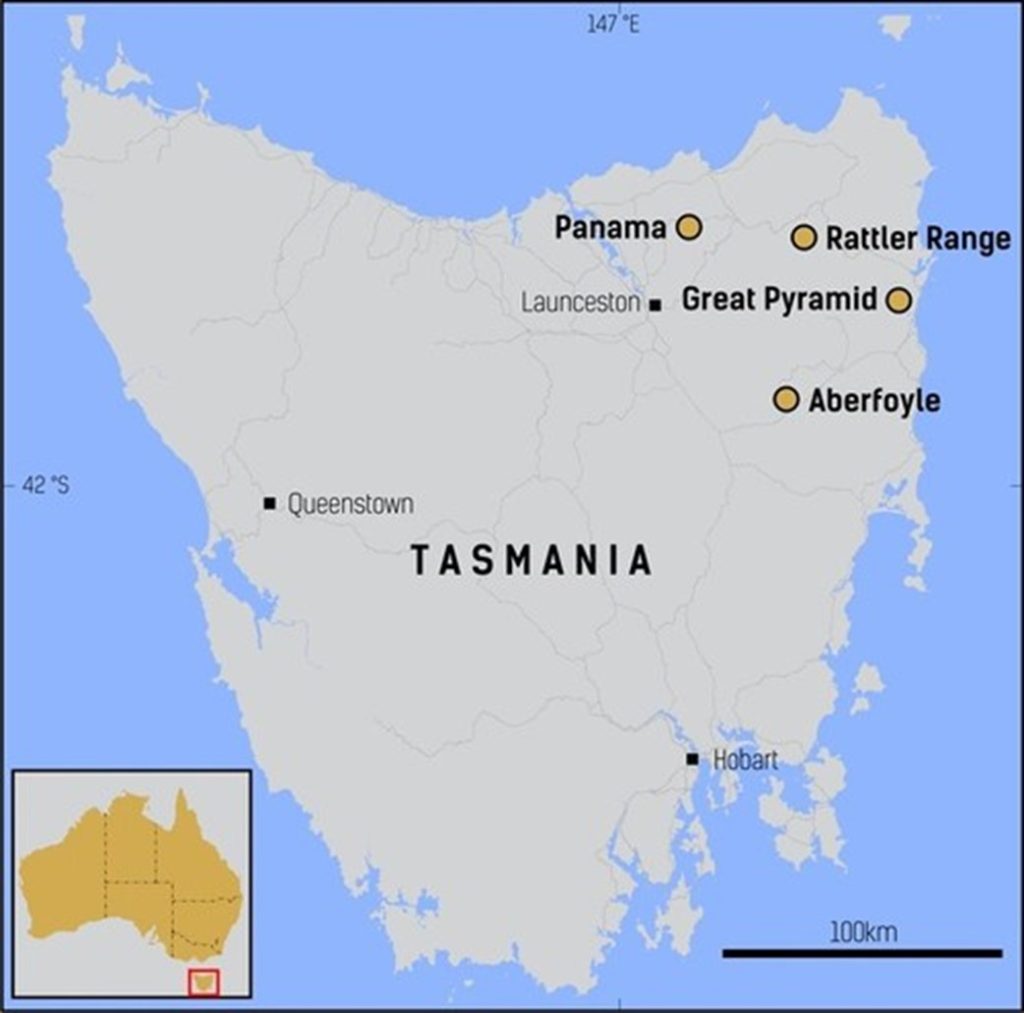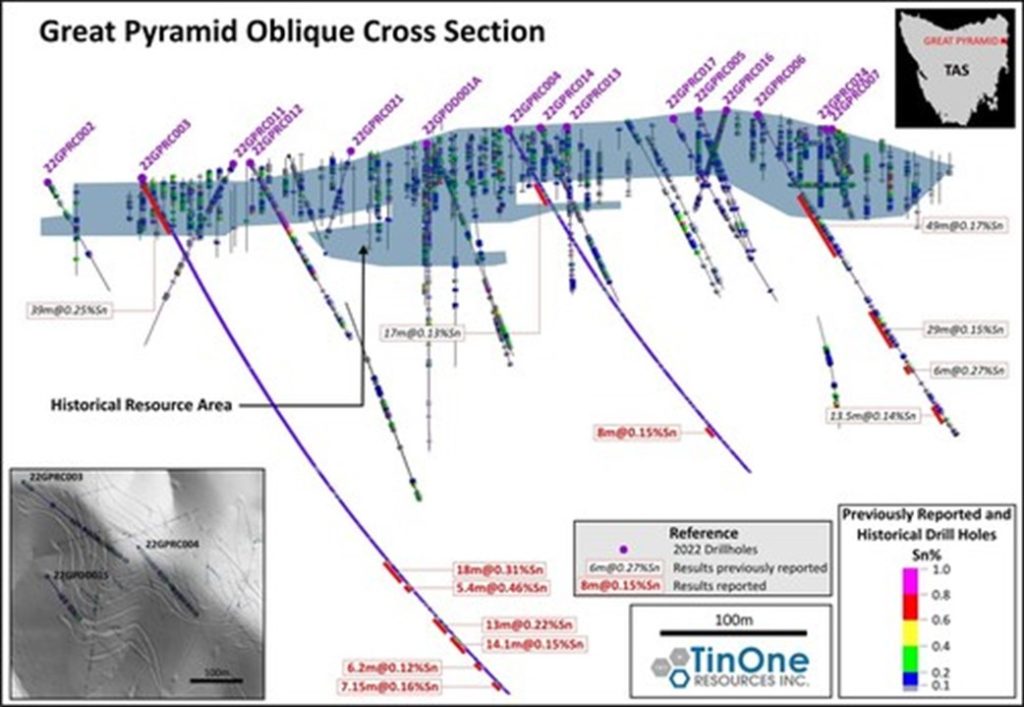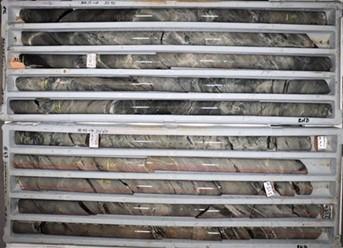
TinOne Reports Strong Results at Depth from its Great Pyramid Project, Tasmania, Australia

TinOne Resources Inc. (TSX-V: TORC) (OTCQB: TORCF) is pleased to provide further results from its Great Pyramid Tin Project located in the tier one mining jurisdiction of Tasmania, Australia. The ongoing program has been successful in continuing to define significant tin mineralisation.
Highlights:
- High grade intersections returned at depth, below historic drilling
- Drill hole 22GPRC003 returned
- 0.31% Sn over 18 metres;
- 0.46% Sn over 5.4 metres; and,
- 0.22% Sn over 13 metres
“The diamond core extension of drill hole 22GPRC003 has delivered outstanding results from considerable depth below the area of the historical resource at Great Pyramid,” commented Chris Donaldson, Executive Chairman. “This drill hole demonstrates the continuation of the system to depth with excellent grade. The holes reported here, in conjunction with historical drill holes and TinOne’s other deeper holes, are allowing us to understand the full extent and geological controls at Great Pyramid.”
Table 1: Great Pyramid RC drill results. More significant results are shown in bold.
| Hole | Intersection Width (m) |
From (m) |
Sn% | Comments |
| 22GPRC003 | 18 | 308 | 0.31 | Diamond tail. Below historical resource area. |
| 5.4 | 330.6 | 0.46 | Diamond tail. Below historical resource area. | |
| 13 | 359 | 0.22 | Diamond tail. Below historical resource area. | |
| 14.1 | 379.15 | 0.15 | Diamond tail. Below historical resource area. | |
| 6.2 | 398.8 | 0.12 | Diamond tail. Below historical resource area. | |
| 7.15 | 420.85 | 0.16 | Diamond tail. Below historical resource area. | |
| 22GPRC004 | 8 | 243 | 0.15 | Diamond tail. Below historical resource area. |
| 22GPDD015 | 48 | 12 | 0.15 | Diamond hole. Predominantly within historic resource area. |
| Including | 3 | 34 | 0.68 | |
| NOTES: All intersections are calculated with a cut-off grade of 0.1% Sn with maximum consecutive internal waste of 4 metres. | ||||
| All intersections are downhole widths, true widths are uncertain. | ||||
| TinOne drill hole numbering is in the form 22GPRCXXX for RC holes and 22GPRDDXXX for diamond holes with numbering allocated in sequence. | ||||
| Analytical results have been received for holes 22GPRC002, 003, 004, 005, 006, 007, 009, 011, 012, 013, 014, 016, 017, 018A, 019, 021, 022 and 024. Hole 22GPRC020 failed at 12 metres and was not assayed. The target area for this hole was drilled by 22GPRC021. | ||||
| Diamond holes completed to-date and with assays pending are 22GPDD10, 22GPDD015 (part) and 22GPDD023. Diamond tail extensions have been completed for RC pre-collar holes 22GPRC003, 22GPRC004, 22GPRC005, 22GPRC006, 22GPRC014 and 22GPRC021 with assays pending for 22GPRC003 (part), 22GPRC014 and 22GPRC021. Diamond tail on 22GPRC018A is currently being drilled. | ||||
In addition to 22GPRC003, one significant intersection is reported here from drill hole 22GPRC004. This intersection is in addition to the previously reported shallower intersection in 22GPRC004 (0.13%Sn over 17 metres from 41 metres; see TinOne News Release September 6, 2022). Geological interpretation is ongoing, however the previously inferred stratigraphic control on Sn grade is supported by preliminary data from the drill holes reported here. The Company’s geologists are working with a specialist sedimentologist, structural geologist and geostatistician to develop a 3-dimensional predictive model which will be used to efficiently plan additional deeper drilling to better understand the extent of the Great Pyramid system.
Drillhole 22GPDD015 was drilled on the periphery of the historical resource area and returned a thick intersection of moderate grade Sn, with thinner high-grade zones. The drillhole provides support for historical drill hole data and contributes to geological understanding of the Great Pyramid system.
Results have been received for 3,120 metres of the Company’s ongoing 5,500 metre drilling program at Great Pyramid. These results represent complete results for 18 Reverse Circulation drill holes, results from two diamond cored holes and partial results from one diamond cored hole, in addition to results from two diamond tails and partial results from one other diamond tail. Assays are being fast tracked and average laboratory turnaround to-date has been 24 days.
Drilling commenced at the Project on April 27, 2022, and one diamond rig is currently operating on site. The initial program consists of approximately 5,500 metres and has several objectives:
- Test the depth and lateral extensions of the mineralised zone
- Test a large-scale IP chargeability anomaly adjacent to the known mineralised zone and
- Obtain grade and continuity data utilising modern drill and analytical techniques.
In addition to the RC and diamond drill results reported here, an additional 1,370 metres of diamond drilling has been completed within, lateral to, and beneath the historical resource area, with assays pending.
Results reported here in Table 1 are from below the historical resource area (see information on page 6) and include mineralisation close to the end of hole 22GPRC003, approximately 380m below surface. Historical drilling and TinOne’s previously reported drill holes below and peripheral to the historic resource model have returned intersections consistent with or higher grade than the historical resource model.
About the Great Pyramid Tin Project
Geological Setting
The Great Pyramid deposit is located around a topographical feature known as Pyramid Hill and is hosted by Silurian to Devonian Mathinna Supergroup sandstones. The mineralization is formed by closely spaced sheeted northeast trending, cassiterite (SnO₂) bearing veins associated with silicification and sericite-pyrite alteration. The deposit style and regional comparisons suggest that a tin-fertile granite exists at depth below the deposit, however this has not been encountered in drilling and the deposit is open at depth. Geological interpretation indicates that certain sedimentary units within the folded Mathinna Supergroup sediments are more favourable hosts and diamond drilling being undertaken by the Company during the current campaign, combined with numerical modelling, will assist in developing a deeper understanding of controls on grade for follow up drilling.
The deposit is currently known over a strike length of more than 500 metres with an average width of approximately 150 metres. The depth extent of the deposit is unknown with only nine historical drill holes greater than 150 metres deep. These rare deeper holes encountered encouraging tin mineralization to depths of approximately 300 metres below surface2.
Historic Resources and Drill Data1
A historical mineral resource estimate was completed on the Great Pyramid Project for TNT Mines Ltd.1,2,3,4,5 (Table 2).
Table 2: Historical Estimate on the Great Pyramid Project1,2,3,4,5
| Great Pyramid Inferred Mineral Resource – JORC 2012 | |||
| Sn% CUT OFF | TONNES (Mt) | GRADE (Sn%) | CONTAINED TIN (kt) |
| 0.1 | 5.2 | 0.2 | 10.4 |
| NOTES | |
| 1. | Source: “Inferred Mineral Resource for the Great Pyramid Tin Deposit in Tasmania, Abbott, 2014” prepared by Jonathon Abbott of MPR for Niuminco Group Ltd. The effective date for the Historical Estimate is February 26, 2014. |
| 2. | The Historical Estimate was prepared using the 2012 Australasian Joint Ore Reserves Committee Code (JORC). The Historical Estimate was not completed using CIM Definition Standards on Mineral Resources and Reserves and is not supported by a technical report completed in accordance with National Instrument 43-101. |
| 3. | The estimation of the Historical Estimate utilized close spaced historic percussion (~85%) and lesser diamond drill holes with drill spacing in the estimation area typically 15 x 30m and locally closer. The Inferred Resource was estimated using Multiple Indicator Kriging method of 1.5 metre down-hole composites within a mineralized domain interpreted from tin grade. Continuity of tin grades was characterised by indicator variograms at 14 indicator thresholds. The estimates are extrapolated a maximum of approximately 30 metres from drilling. Gemcom software was used for data compilation, domain wireframing, and coding of composite values, and GS3M was used for resource estimation. Resources were estimated into 15 by 30 by 3 m blocks (across strike, strike, vertical) aligned with the 067o trending drilling grid. Planview dimensions of the blocks approximate average drill hole spacing. For precise volume representation, resource estimates include the proportion of block volumes within the mineralised domain below surface. The modelling included a three pass octant based search strategy. Search ellipsoid radii (across strike, along strike, vertical) and minimum data requirements for these searches were: Search 1: 20 by 20 by 4 m (16 data), Search 2: 30 by 30 by 6 m (16 data), Search 3:30 by 30 by 6 (8 data). Model validation included visual comparison of model estimates and composite grades, and trend (swath) plots, along with comparison with estimates from alternative estimation methodologies and previous model estimates. The Historical Estimate is restricted to the area of close spaced drilling and 90% of the resource occurs within 40 metres of surface. Although the limited deeper drilling has encountered mineralized material this was not included in the Historical Estimate. The mineralised domain wireframe used to constrain the estimates was primarily interpreted on the basis of tin assay grades and restricts estimates to the volume tested by reasonably close spaced drilling. The wireframe was trimmed by the cross cutting dyke and soil units interpreted from drill hole logging and geological mapping. Investigation of alternative interpretations included resource estimation with assumed dominant mineralisation controls varying from flat lying to steeply west dipping. These models did not give significantly different total estimates |
| 4. | The reader is cautioned that the Historical Estimate is considered historical in nature and as such is based on prior data and reports prepared by previous property owners. The reader is cautioned not to treat them, or any part of them, as current mineral resources or reserves. A qualified person has not done sufficient work to classify the Historical Estimates as current resources and TinOne is not treating the Historical Estimates as current resources. Significant data compilation, re-drilling, re-sampling and data verification may be required by a qualified person before the Historical Estimates can be classified as a current resource. There can be no assurance that any of the historical mineral resources, in whole or in part, will ever become economically viable. In addition, mineral resources are not mineral reserves and do not have demonstrated economic viability. Even if classified as a current resource, there is no certainty as to whether further exploration will result in any inferred mineral resources being upgraded to an indicated or measured mineral resource category. |
| 5. | The Company has determined that the Historical Estimate is reliable, and relevant to be included here because it was estimated using close spaced drilling with modern geostatistical methods and software by an experienced resource geologist and provides a guide to the location of the Great Pyramid mineralised zone. This will be used to assist in targeting drilling to undertake testing of the extent and grade of the mineralised system. |
Quality Assurance / Quality Control
Drill core and RC samples were shipped to ALS Limited in Brisbane, Australia for sample preparation and for analysis. The ALS, Brisbane facilities are ISO 9001 and ISO/IEC 17025 certified. Tin and tungsten are analysed by ICP-MS following lithium borate fusion (ALS method ME-MS85), overlimit results are reanalysed by XRF (ALS method XRF15b). Forty-eight element multi-element analyses are conducted by ICP-MS with a four-acid digestion (ALS method ME-MS61).
Control samples comprising certified reference samples, duplicates and blank samples were systematically inserted into the sample stream and analyzed as part of the Company’s quality assurance / quality control protocol.
About TinOne
TinOne is a TSX Venture Exchange listed Canadian public company with a high-quality portfolio of tin projects in the Tier 1 mining jurisdictions of Tasmania and New South Wales, Australia. The Company is focussed on advancing its highly prospective portfolio while also evaluating additional tin opportunities. TinOne is supported by Inventa Capital Corp.
Qualified Person
The Company’s disclosure of technical or scientific information in this press release has been reviewed and approved by Dr. Stuart Smith., Technical Advisor for TinOne. Dr. Smith is a Qualified Person as defined under the terms of National Instrument 43-101.

Figure 1: Location of the Company’s projects in the mining friendly jurisdiction of Tasmania. (CNW Group/TinOne Resources Corp.)

Figure 2: Great Pyramid cross-section showing the location of 22GPRC003 and 22GPRC004 in relation to historical drilling and TinOne’s previously reported holes. (CNW Group/TinOne Resources Corp.)

Figure 3: Great Pyramid diamond core (22GPRC003 309.15-316.60m), beneath historic resource area. This interval 308.0 to 326.0m assayed at 0.31% Sn. The interval 313.0 to 315.0m assayed at 0.96% Sn. Intense sheeted and stockwork quartz-carbonate-cassiterite veining in silicified, medium to coarse grained sandstones and intercalated siltstones. (CNW Group/TinOne Resources Corp.)

Figure 4: Great Pyramid diamond core (22GPRC014 218.25-220.65m), beneath historic resource area. Strongly sheeted quartz-carbonate veining in silicified, medium to coarse grained sandstones. Historical and current exploration indicates that veins of this style are cassiterite-bearing and are typical of the mineralised zones. Results pending. (CNW Group/TinOne Resources Corp.)
MORE or "UNCATEGORIZED"
Kuya Silver Confirms High-Grade Silver-Gold Vein Mineralization at Umm-Hadid with Initial Drill Results up to 1483.9 g/t AgEq over 2 Metres
Kuya Silver Corporation (CSE: KUYA) (OTCQB: KUYAF) (FSE: 6MR1) is... READ MORE
First Phosphate Closes Final Tranche of Oversubscribed Private Placement
First Phosphate Corp. (CSE: PHOS) (OTCQX: FRSPF) (FSE: KD0) is... READ MORE
GFG Receives Final Payment from the Sale of its Rattlesnake Hills Gold Project
GFG Resources Inc. (TSX-V: GFG) (OTCQB: GFGSF) announces that i... READ MORE
Goliath Receives $1,730,882 Through Warrant Exercises, Inclusive Of Crescat Capital A Longtime Strategic And Cornerstone Shareholder
Goliath Resources Limited (TSX-V: GOT) (OTCQB: GOTRF) (FSE: B4IF)... READ MORE
Robex Pours First Gold at Kiniéro on Schedule and Budget
Highlights: Gold bar weighing 2.64 kilograms (85 oz) poured in th... READ MORE












